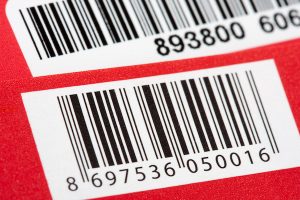In most industries, barcodes of one type or another can be found. Barcode applications have transformed the face of manufacturing, processing, and tracking. Industries like food and beverage, retail, medical, pharmaceutical, electronics, distribution, aerospace and automotive industries, to name a few, rely on barcodes in one way or another. They are found in every consumer and electronic product – from the box holding a pair of new shoes to the battery in every cell phone.
Using 1-D or 2-D barcodes reduces overhead costs by automating and simplifying supply chain management, inventory, check-out and purchasing.
Barcodes are machine-readable patterns applied to products, parts, or packages. They contain data used for a variety of informational marketing purposes; as well as for tracking products through their lifecycle.
Originally patented in 1952, it wasn’t until 1974 that the first product – a package of Wrigley’s gum – was scanned at a supermarket in Ohio. Today, barcodes come in many different formats, everything from a row of simple lines that are referred to as 1-D (one-dimensional) barcodes to dots and squares that form a 2-D (2-dimensional) code. QR (Quick-Response) and DataMatrix codes are among the most popular 2D codes. The more advanced 2-D code allows users to store and retrieve far more data than possible with a 1-D code. The reason being that 1-D codes only contain data in the horizontal direction, whereas 2-D contain information both horizontally and vertically.
In the early days of barcodes, they could only be read by lasers. Laser scanners use a laser beam as the light source and typically use oscillating mirrors, or rotating prisms to scan the laser beam back and forth across the barcode. A photodiode then measures the reflected light, then an analog signal is created from the photodiode, which is then converted into a digital signal.
Vision-enabled readers essentially consist of a digital camera that acquires a picture of the code. Then a microprocessor, running special image-processing software, locates and decodes the code before distributing the resulting data across a network.
One of the biggest delineations of choosing an image sensor, or camera, is resolution. Image resolution refers to how many individual pixels make up each image. When it comes to matching a vision-enabled reader’s resolution to an application, one of the most common criteria is pixels per module (PPM). PPM refers to how many pixels it will take to cover one cell or module of the code and will confirm whether the camera has enough resolution to read the code. PPM is calculated by dividing the camera’s resolution in one direction (for example, 752 pixels for a standard resolution reader) by the Y-field of view in millimeters (78 mm), and then dividing the code size in millimeters by the modules (12 mm/22 modules). Finally, multiply these numbers together (5.26 PPM).
At Universe Optics, we pride ourselves in stocking and manufacturing precision lenses to be used in barcode scanning technology. You can depend on us to make sure that the lens you buy or have us create will meet your unique specifications.
As mentioned, barcode technology is used in most industries; it’s safe to assume that sooner than later it will be everywhere. If you have a design in mind, we are here to ensure the lens necessary will be precisely what you expect.